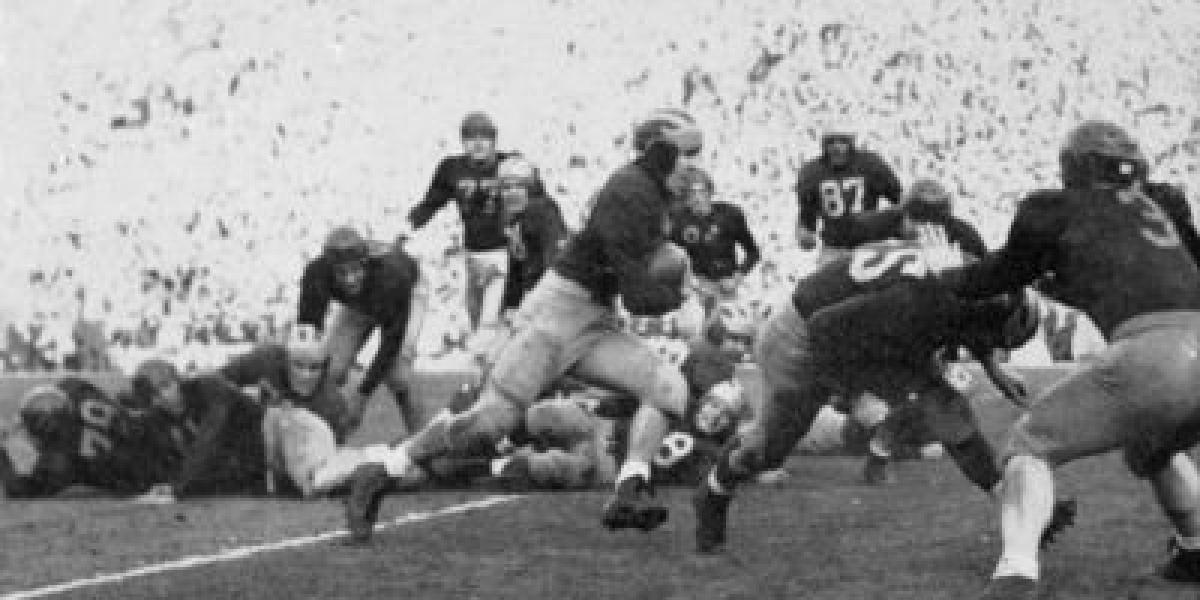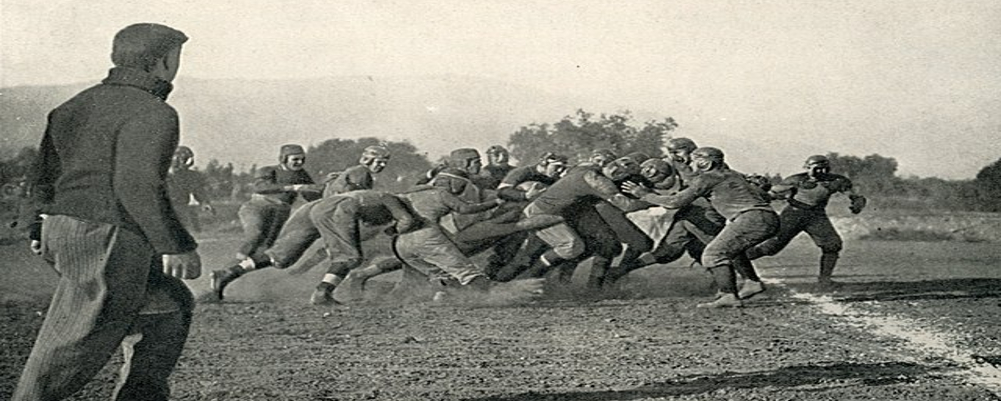This ushered in the era of two-platoon football and Timothy Brown of Football Archaeology wrote a great post on the first All-America team from this new era.
Transcribed Conversation with Timothy Brown on the 1st Two-Platoon All-America Team
Hello, my football friends. This is Darin Hayes of PigskinDispatch.com. Welcome once again to The Pig Pen, your portal to positive football history, and welcome to another day where we get to talk to footballarchaeology.com's Timothy P. Brown about one of the great tidbits that he writes every day about football of yesteryear. Tim, welcome back to The Pig Pen.
Hey, Darin. Thank you for having me on. I look forward to talking about two-platoon football.
Yeah, why don't you first let's give you a title? You titled this tidbit back in October of 2022, the first two-platoon All-America team. And why don't you explain to the audience what two-platoon football is and what was significant about this All-America team? Yeah.
So, back in the day, if you played a football game, you put your 11 guys or 15 guys out there, and that's who you played with. There were no substitutions. Then they started allowing substitutions, but pretty much, once you left the game, you were out, just like soccer remains today.
It was the same game; they came from the same origin, so similar rules applied. But over time, football allowed substitutions in certain instances, but for the most part, until 1941, if you, once you're out, you're out. There were no go-backs. And so, in 1941, because of concern about the, you know, there were a lot of guys enlisting, and they were, you know, I'm not sure if they were being drafted yet or not, but either way, there were a lot of college-age men heading into the military, even, you know, pre-Pearl Harbor.
And so, they were concerned about roster sizes. And so, they passed a rule allowing coaches to substitute anytime they wanted to in a game. And so, the funny thing is, this is, you know, I think at multiple levels, this is a story of how much people follow tradition as much as the rules.
So, even though the rule was passed in 41, pretty much without exception, the only people who got substituted, in the way that we think about it today, were kickers and punters. You know, coaches would bring in those kinds of people, but they and even those were very few because typically your punter, the kicker was your halfback or somebody, you know, one of the regular players. And so, but then in 1945, Michigan had a really depleted roster, and they were going to play, you know, Army, which had, you know, Blanchard and Davis and a bunch of other guys.
And they just knew they were just going to get their lunch handed to them. And so, Fritz Crisler, the coach, was looking for, you know, some way to try to, you know, give his team an advantage. And so, he realized, hey, the way this rule is written, I can swap my offense and defense out whenever I want to or swap players in whenever I want to.
Even though nobody's done it, the rule says I can't. So, from his vantage point, he was exploiting a loophole, right? I mean, not in the way the rule was written, but in the way it had been traditionally applied. So, he does that against the Army.
He basically plays offensive and defensive units. I think there were three or four guys who played both ways. They're, you know, that much better players.
Other coaches picked up on that, and they started doing it. Over the next couple of years, the two platoons, you know, the old no substitution was called the single tune. And two platoon, what became, you know, kind of the standard term for swapping offensive and defensive players.
And so, then, that's fine. And there, it was raining, you know, gaining speed. But it wasn't until 1948 that anyone named an all-American team with two platoons.
So, in 1945, 46, and 47, they still kept naming a single platoon all-American team. So, 11 guys, no specialists, right? And so, finally, this organization called the NEA was a big one, kind of like the UPI or the AP or somebody, you know, along those lines at the time. They named a two-platoon all-American team in 1948.
So, just, you know, some of the guys whose names, you know, a lot of people probably will recognize as Charlie Justice, who was back at, you know, North Carolina, Doke Walker of SMU, Eddie LeBaron, who played at Pacific, some guy named Darryl Royal, who was at Texas. Leon Hart was the only player named to play on both the offensive and defensive teams at Notre Dame. So, then the other thing I just said is that it doesn't so much relate to 1940. I just find it really interesting that it was not until the 1980s that all-American teams added kickers and punters to their rosters, right? So, I mean, it took all that, so, you know, we had moved into specialist players.
I mean, even through the 60s, there were still a lot of kickers and punters who were everyday players, right? You know, Don, like I grew up, so Don Chandler, an end originally and kicked, was a kicker as well. Honey Anderson was the punter, and he was a halfback, you know, so there was a lot of that going on. And like George Blanda, you know, he was a quarterback.
Yeah, Lou Groza is a lineman. Yeah, exactly. I mean, you can just go through it; there's a whole slew of guys like that.
And so, but so anyways, you know, but clearly specialists had come into the game, especially after the, you know, onset of the soccer-style kicker in the 60s, you know, with the Go-Go Axe and others. But it wasn't until the 80s that they, you know, they named separate punters and kickers. So just, you know, it's an amazing thing that it took that long.
Yeah. Wow. I didn't realize that about the punters and kickers.
I thought that would have been, you know, going on for a while. I was like, man, that's great stuff. So, you know, I guess the kickers today, even though they feel that they're shunned by the rest of football and looked down upon a little bit of not being, you know, sometimes called not real football players and everything, they would have been pissed back in the 70s when they weren't even honored.
Yeah. Well, you know, and the funny thing about it is like, you know, if you go back and you read the newspaper reports of guys who were named all American in the teens and the twenties and thirties and whatnot, a lot of backs were named, you know, especially in the heavy punting years, you know, they were named as much for their punting ability as for their running ability or their passing ability. You know, punting was just so important to the game, and they were the ones who did it.
Yeah. It wasn't like Jim Thorpe, one of the greatest punters and dropkickers ever. And that was sort of what some of his fame was besides his running.
Yeah. Yeah. Yeah.
Right. I mean, that's the triple threat. You know, the whole thing is running, passing, and kicking. You know, it is either a form of kicking or typically punting. So yeah, I mean, it was, there's, I mean, you just can go on and on about the, the number of guys who, who were especially running backs with, you know, fullbacks, fullbacks, a lot of times were like the big studs of the teams in the twenties and thirties.
And, you know, a lot of them were, were really, really effective punters. Yeah. So I guess, you know, World War II changed the world, and it changed the world of football, too.
So it's sort of that line of debarkation between the single platoon and the dual platoon because of the rule changes and, you know, a substitution. So very interesting. Great stuff.
Well, then, in college, they went back to single platoon in 52. The pros, you know, once the pros went, you know, swapping offensive, offense, and defense, they never looked back, you know, their game was much more about entertainment and everything. But once you went to platoon, you needed more coaches and bigger rosters.
The coaches became more specialized. I mean, think about how much more complicated the game has become. And a lot of that's because it's two platoons, you know if you only have so many minutes a week to impart, you know, knowledge and techniques to players, if you got to cut it in half, well, you know, it can't be as, you know, you just can't complicate it as much.
So, these coaches studied just defense and coached just defense. So, I mean, it's, you know, certainly among the top four, five, six rules in terms of the effect on the game, but the colleges went back in 52 to dual platoon really as a cost-saving measure. And then, you know, kind of slowly, and then especially in the late fifties and early sixties, swapped it over.
By 64, Katie had barred the door, you know, a total of two platoons. Wow. Amazing stuff.
And you sit there, and you think about how good athletes these guys had to be to be on the field for, you know, 60 minutes or 48 minutes, whatever it was at the time. It might've been longer than that back in that era, but they had longer, longer halves back then, too, like 35-minute halves. Yeah, that was more; that was all like pre-1912 or something like that.
I mean, that was earlier. Yeah. But I mean, just think about it in terms of just the shape of, you know, what players look like.
I mean, you know, you've got these six, eight, six, nine, 340-pound guys running around now, can't play a 60-minute game. They just can't. No, they can't even take all the offensive-defensive snaps, you know, unless you're an offensive lineman or a quarterback, you're, you're probably going to get substituted in while your team is on the field, and that, uh, that genre, that offense or defense.
Yeah. Yeah. And you know, my part of my argument is always looking at world-class rugby teams, and they've got guys for six, three, two 60, you know, running around as the, you know, kind of the forwards blocking, um, you know, they're the guys leading the scrum, but there aren't, you know, there aren't the kind of guys that you see in the NFL or, you know, almost any major college team.
And nowadays, half the D3 teams have kids who weigh more than 300 pounds, right? Um, you know, so it's, you know, you just can't, you can't play like that in a, in a 60-minute game, especially when there were far, there weren't TV titles, there weren't, you know, anywhere, there weren't anywhere near the number of passing completions or weren't that many balls out of bounds. The ball went out of bounds, and the clock kept running.
I mean, all that kind of, you know, the rules were so different. Um, the body types were different, but yeah, amazing stuff. Yeah.
Tremendous. Tim, you know, we enjoy these stories and, and, you know, learning about these little pieces of football, which this one's a pretty major story of the evolution of football, but, uh, you know, you, you share with these, uh, these stories and sometimes they're just fun. Sometimes they're really serious and game-changing like this one was. You call them your daily tidbits, and maybe you could tell folks how they can enjoy your daily tidbits.
Yeah. So, you know, the best thing is just to go to footballarchaeology.com and, you know, subscribe. You can subscribe for free.
You'll get an email. As a result, you'll get an email every night at seven o'clock with that day's story. Otherwise, you can follow me on Twitter, sometimes called X, but I don't call it that.
And then, catch me on the Substack app on threads or just bookmark the site and pop in whenever you want. Well, Tim, we appreciate you educating us and sharing your knowledge on football history. And we'd love to talk to you again next Tuesday about another one of your tidbits.
Well, I think we can find something to chat about next week. I'll leave that up to you. Thanks much.
Transcribed by TurboScribe.ai.



